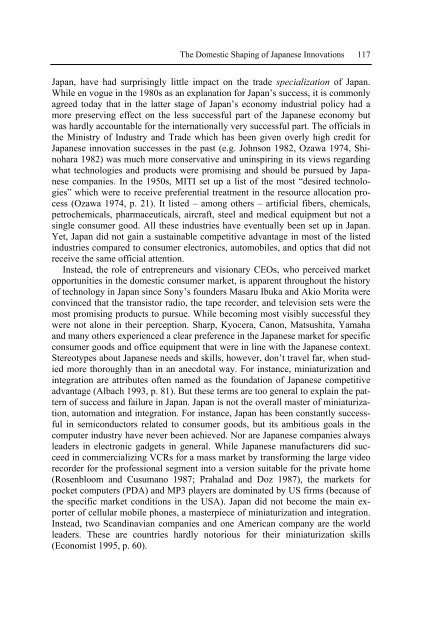Management of Technology and Innovation in Japan
Management of Technology and Innovation in Japan
Management of Technology and Innovation in Japan
Create successful ePaper yourself
Turn your PDF publications into a flip-book with our unique Google optimized e-Paper software.
The Domestic Shap<strong>in</strong>g <strong>of</strong> <strong>Japan</strong>ese <strong>Innovation</strong>s 117<br />
<strong>Japan</strong>, have had surpris<strong>in</strong>gly little impact on the trade specialization <strong>of</strong> <strong>Japan</strong>.<br />
While en vogue <strong>in</strong> the 1980s as an explanation for <strong>Japan</strong>’s success, it is commonly<br />
agreed today that <strong>in</strong> the latter stage <strong>of</strong> <strong>Japan</strong>’s economy <strong>in</strong>dustrial policy had a<br />
more preserv<strong>in</strong>g effect on the less successful part <strong>of</strong> the <strong>Japan</strong>ese economy but<br />
was hardly accountable for the <strong>in</strong>ternationally very successful part. The <strong>of</strong>ficials <strong>in</strong><br />
the M<strong>in</strong>istry <strong>of</strong> Industry <strong>and</strong> Trade which has been given overly high credit for<br />
<strong>Japan</strong>ese <strong>in</strong>novation successes <strong>in</strong> the past (e.g. Johnson 1982, Ozawa 1974, Sh<strong>in</strong>ohara<br />
1982) was much more conservative <strong>and</strong> un<strong>in</strong>spir<strong>in</strong>g <strong>in</strong> its views regard<strong>in</strong>g<br />
what technologies <strong>and</strong> products were promis<strong>in</strong>g <strong>and</strong> should be pursued by <strong>Japan</strong>ese<br />
companies. In the 1950s, MITI set up a list <strong>of</strong> the most “desired technologies”<br />
which were to receive preferential treatment <strong>in</strong> the resource allocation process<br />
(Ozawa 1974, p. 21). It listed – among others – artificial fibers, chemicals,<br />
petrochemicals, pharmaceuticals, aircraft, steel <strong>and</strong> medical equipment but not a<br />
s<strong>in</strong>gle consumer good. All these <strong>in</strong>dustries have eventually been set up <strong>in</strong> <strong>Japan</strong>.<br />
Yet, <strong>Japan</strong> did not ga<strong>in</strong> a susta<strong>in</strong>able competitive advantage <strong>in</strong> most <strong>of</strong> the listed<br />
<strong>in</strong>dustries compared to consumer electronics, automobiles, <strong>and</strong> optics that did not<br />
receive the same <strong>of</strong>ficial attention.<br />
Instead, the role <strong>of</strong> entrepreneurs <strong>and</strong> visionary CEOs, who perceived market<br />
opportunities <strong>in</strong> the domestic consumer market, is apparent throughout the history<br />
<strong>of</strong> technology <strong>in</strong> <strong>Japan</strong> s<strong>in</strong>ce Sony’s founders Masaru Ibuka <strong>and</strong> Akio Morita were<br />
conv<strong>in</strong>ced that the transistor radio, the tape recorder, <strong>and</strong> television sets were the<br />
most promis<strong>in</strong>g products to pursue. While becom<strong>in</strong>g most visibly successful they<br />
were not alone <strong>in</strong> their perception. Sharp, Kyocera, Canon, Matsushita, Yamaha<br />
<strong>and</strong> many others experienced a clear preference <strong>in</strong> the <strong>Japan</strong>ese market for specific<br />
consumer goods <strong>and</strong> <strong>of</strong>fice equipment that were <strong>in</strong> l<strong>in</strong>e with the <strong>Japan</strong>ese context.<br />
Stereotypes about <strong>Japan</strong>ese needs <strong>and</strong> skills, however, don’t travel far, when studied<br />
more thoroughly than <strong>in</strong> an anecdotal way. For <strong>in</strong>stance, m<strong>in</strong>iaturization <strong>and</strong><br />
<strong>in</strong>tegration are attributes <strong>of</strong>ten named as the foundation <strong>of</strong> <strong>Japan</strong>ese competitive<br />
advantage (Albach 1993, p. 81). But these terms are too general to expla<strong>in</strong> the pattern<br />
<strong>of</strong> success <strong>and</strong> failure <strong>in</strong> <strong>Japan</strong>. <strong>Japan</strong> is not the overall master <strong>of</strong> m<strong>in</strong>iaturization,<br />
automation <strong>and</strong> <strong>in</strong>tegration. For <strong>in</strong>stance, <strong>Japan</strong> has been constantly successful<br />
<strong>in</strong> semiconductors related to consumer goods, but its ambitious goals <strong>in</strong> the<br />
computer <strong>in</strong>dustry have never been achieved. Nor are <strong>Japan</strong>ese companies always<br />
leaders <strong>in</strong> electronic gadgets <strong>in</strong> general. While <strong>Japan</strong>ese manufacturers did succeed<br />
<strong>in</strong> commercializ<strong>in</strong>g VCRs for a mass market by transform<strong>in</strong>g the large video<br />
recorder for the pr<strong>of</strong>essional segment <strong>in</strong>to a version suitable for the private home<br />
(Rosenbloom <strong>and</strong> Cusumano 1987; Prahalad <strong>and</strong> Doz 1987), the markets for<br />
pocket computers (PDA) <strong>and</strong> MP3 players are dom<strong>in</strong>ated by US firms (because <strong>of</strong><br />
the specific market conditions <strong>in</strong> the USA). <strong>Japan</strong> did not become the ma<strong>in</strong> exporter<br />
<strong>of</strong> cellular mobile phones, a masterpiece <strong>of</strong> m<strong>in</strong>iaturization <strong>and</strong> <strong>in</strong>tegration.<br />
Instead, two Sc<strong>and</strong><strong>in</strong>avian companies <strong>and</strong> one American company are the world<br />
leaders. These are countries hardly notorious for their m<strong>in</strong>iaturization skills<br />
(Economist 1995, p. 60).


